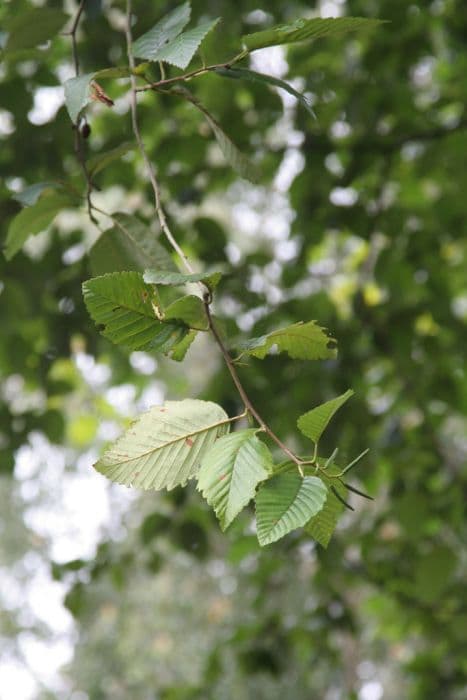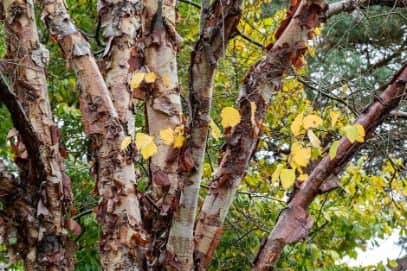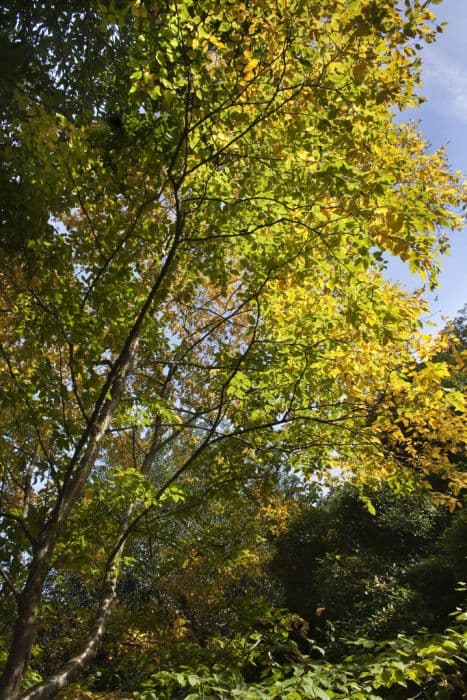Golden Alder Alnus incana 'Aurea'

ABOUT
The plant known as Golden Alder features bright golden-yellow leaves that provide a striking color contrast compared to the more typical green foliage found in many landscapes. The leaves of this deciduous tree emerge with a vibrant hue in spring and gradually transition to a lighter greenish-gold as the season progresses. During the autumn, the foliage again changes, exhibiting a warm golden color before the leaves eventually fall off. Golden Alder has a classic leaf shape characteristic of many alders, with a rounded to broadly elliptical form that typically comes to a point at the tip and features serrated edges. The leaves are arranged in an alternate pattern along the branches, creating a textured, layered appearance within the canopy. In winter, when the branches are bare, they exhibit a rich, reddish-brown bark that adds visual interest to the winter landscape. During the spring, Golden Alder produces catkins, which are pendulous, elongated clusters of flowers that provide subtle ornamental value. The male catkins are longer and more conspicuous, with a yellowish color, while the female catkins are smaller, denser, and have a reddish tint. Over time, these mature into small, woody cones that persist on the tree, adding another element of texture throughout the year. Overall, Golden Alder is appreciated for its colorful foliage and adaptive nature, making it a charming addition to gardens that are designed with year-round visual interest in mind. The plant's features contribute to its popularity as a landscape specimen, offering a beautiful display across the seasons without the need for the knowledge of its exact dimensions.
About this plant
 Names
NamesFamily
Betulaceae.
Synonyms
Golden Alder, Golden Speckled Alder, Yellow-leaf Alder.
Common names
Alnus incana 'Aurea'.
 Toxicity
ToxicityTo humans
Grey alder is not commonly associated with toxicity to humans. There are no well-documented cases of poisoning or serious adverse health effects from ingestion or contact with this tree. However, as with any plant material, individual allergies or sensitivities could occur, and caution is always advised when handling or ingesting plants that one is not familiar with.
To pets
Grey alder is not known for being toxic to pets such as dogs or cats. While there are no significant toxins reported in this plant that would typically cause symptoms of poisoning, it is always prudent to prevent pets from ingesting plants, as individual sensitivities may vary, and consuming non-food items can cause digestive upset or other health issues in pets.
 Characteristics
CharacteristicsLife cycle
Perennials
Foliage type
Deciduous
Color of leaves
Yellow-green
Flower color
Mixed
Height
40 feet (12 meters)
Spread
20 feet (6 meters)
Plant type
Tree
Hardiness zones
2
Native area
Europe
Benefits
 General Benefits
General Benefits- Ornamental Appeal: The plant features attractive golden-yellow foliage that provides visual interest to gardens and landscapes.
- Adaptability to Soil Conditions: Alnus incana 'Aurea' can thrive in a wide range of soil types, making it a versatile choice for various planting environments.
- Wildlife Support: Its catkins serve as a food source for birds and other wildlife, fostering a biodiverse ecosystem.
- Erosion Control: The plant's root system can help to stabilize soil and prevent erosion, especially along riverbanks or slopes.
- Flood Tolerance: It is well-suited for areas prone to flooding or with high water tables, as it can tolerate wet soil conditions.
- Low Maintenance: Once established, it requires minimal care, making it suitable for low-maintenance landscaping.
- Rapid Growth: This species is known for its fast growth rate, providing quick results for landscaping projects.
- Pollution Tolerance: Alnus incana 'Aurea' is tolerant of urban pollution, making it suitable for city environments and roadside planting.
 Medical Properties
Medical PropertiesThis plant is not used for medical purposes.
 Air-purifying Qualities
Air-purifying QualitiesThis plant is not specifically known for air purifying qualities.
 Other Uses
Other Uses- Woodworking: The wood of the Grey Alder is often used for carving and turning due to its even texture and workability.
- Dye Production: The bark of the Grey Alder can be used to produce a dye that ranges in color from reddish to dark brown, suitable for textiles.
- Photography: Some enthusiasts use the bark and catkins of the Grey Alder to make organic photographic prints, exploiting its natural tannins.
- Wetland Restoration: Grey Alder is also planted in wetland areas to stabilize soil and help in the restoration of natural habitats.
- Erosion Control: Because of its extensive root system, the Grey Alder is used on riverbanks and slopes to prevent soil erosion.
- Wildlife Shelter: The dense foliage provides shelter and nesting sites for birds and other wildlife.
- Tanning Leather: Tannins extracted from the Grey Alder's bark were historically used in the tanning process of leather.
- Fishery Support: When planted along streams and rivers, the Grey Alder's roots increase the complexity of the habitat, providing better conditions for fish, such as trout.
- Soil Improvement: Grey Alder is known to improve soil fertility by fixing nitrogen, making it valuable for land reclamation and forestry.
- Winter Interest: The Golden Alder's yellow winter buds and attractive bark texture provide visual interest in the landscape during the dormant season.
Interesting Facts
 Feng Shui
Feng ShuiThe European Grey Alder is not used in Feng Shui practice.
 Zodiac Sign Compitability
Zodiac Sign CompitabilityThe European Grey Alder is not used in astrology practice.
 Plant Symbolism
Plant Symbolism- Resilience: The Alnus incana 'Aurea', commonly known as the Gray Alder, is known for its ability to thrive in difficult conditions, symbolizing the resilience and adaptability of the human spirit.
- Protection: Alders have been traditionally believed to offer protection from negative energies and spirits, representing a shield against harm.
- New Beginnings: Because alder trees are pioneer species in disturbed areas, they symbolize the start of new endeavors and the courage to begin anew.
- Strength: The wood of the Gray Alder is both flexible and durable, making it a symbol of inner strength and the ability to withstand life's challenges.
- Prophecy: In some traditions, alder branches were used for divination and oracles, and thus the tree is often connected to foresight and spiritual insight.
 Water
WaterThe European grey alder, under typical garden conditions, typically prefers consistent moisture but is quite adaptable once established. Initially, water the plant deeply once or twice a week to promote root growth. Ensure you're providing about 1.5 gallons per week for young trees, adjusting for rainfall and soil conditions. Once established, they can withstand some drought, but it's advisable to water deeply every two weeks, especially during extended dry periods. Adjust the amount and frequency based on soil drainage and weather; they may need more frequent watering in hot, dry climates or if planted in sandy soils.
 Light
LightThe European grey alder thrives best in full sun to partial shade. It's adaptable but it develops its best form and healthiest foliage when given ample sunlight. Ideally, plant it in a spot where it can receive at least six hours of direct sunlight daily. However, it can tolerate light shade, especially in hotter climates where afternoon shade can prevent scorching.
 Temperature
TemperatureThe European grey alder is hardy and can withstand a wide range of temperatures, faring well in USDA zones 2 through 6. It can survive minimum temperatures down to -50 degrees Fahrenheit and can handle the heat of summer well. The optimal growing temperatures are between 70 and 85 degrees Fahrenheit; extreme heat may stress the plant, so ensure it has adequate water during hot spells.
 Pruning
PruningEuropean grey alder can benefit from pruning to shape the tree, remove any damaged or wayward branches, and encourage a strong structure. Prune during the dormant season, usually late winter or early spring, before new growth starts. Remove dead, diseased, or damaged branches as needed and thin out crowded branches every few years to open up the canopy and improve air circulation.
 Cleaning
CleaningAs needed
 Soil
SoilThe Gray Alder grows best in moist, well-drained soil rich in organic matter, with a pH of 6.0-7.5. A mix containing loam and peat with some sand or perlite for drainage suits this species, mirroring its natural habitat preferences.
 Repotting
RepottingGray Alders are large trees, hence repotting is not applicable. They are planted directly into the ground where they are to grow permanently.
 Humidity & Misting
Humidity & MistingThe Gray Alder tolerates a wide range of humidity levels and typically adapts to the local conditions, without needing specific humidity requirements.
 Suitable locations
Suitable locationsIndoor
Not suitable for indoor growth; Gray Alder is a large tree.
Outdoor
Plant in a sunny spot, with moist, well-drained soil.
Hardiness zone
2-6 USDA
 Life cycle
Life cycleThe Golden Alder (Alnus incana 'Aurea') begins its life cycle as a dormant seed, which germinates in late winter or spring when soil temperatures and moisture levels become suitable. Following germination, the seedling goes through a rapid growth phase over spring and summer, developing a root system and foliage. As a fast-growing deciduous tree, it enters a vegetative stage where it continues to expand in height and width annually, producing characteristic golden-yellow leaves during the spring. The tree reaches maturity in several years and starts to produce catkins—male catkins are long and pendulous, and female catkins are shorter and more upright. After pollination, usually by wind, the female catkins develop into small woody cones that contain seeds, completing the reproductive cycle. The Golden Alder's life cycle continues year after year, with the tree potentially living and reproducing for several decades.
 Propogation
PropogationPropogation time
Spring to Summer
The most popular method for propagating the Gray Alder 'Aurea' is through softwood cuttings. This process typically takes place in the late spring or early summer when new growth is still tender and pliable. To propagate, a 4 to 6-inch cutting from a healthy, young branch is taken. The bottom leaves are removed, and the cut end is often dipped in rooting hormone to encourage root growth. The cutting is then placed in a potting mix that is kept moist but not soggy. The pot is set in a warm, bright area but out of direct sunlight to avoid scorching. With proper care, the cutting will root and can be transplanted to a permanent location in the landscape.









